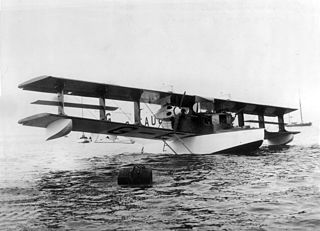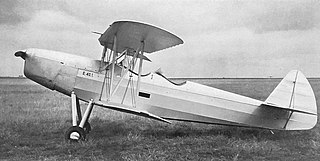
The Aero A.23 was a Czechoslovakian airliner of the 1920s. Aero Vodochody had produced the first Czech airliner, the A.10, four of which had served with ČSA, the national airline. The A.23, another biplane, was bigger, more powerful and could carry more passengers.

The Saunders Kittiwake was a British amphibian flying-boat built by S.E. Saunders at East Cowes, Isle of Wight.
The Indraéro Aéro 30 is a single seat, single engined sports biplane designed in France in the late 1960s. Only one was built.
The Lemberger LD20b was a single-engine cantilever biplane designed to be easily towable behind a car. Built in Germany in 1971, it made several flights but did not enter production.

The Praga E-40 was a single engine, two seat, biplane basic trainer, built in Czechoslovakia in the mid-1930s.
The Hovey Delta Bird is an American ultralight aircraft that was designed by Bob Hovey in 1982 and supplied as plans for amateur construction.
The Friesley Falcon was a twin engine, 12 passenger biplane airliner, designed and flown in the United States in 1921. The only example built was later sold to China.
The Corcoran 65-1 was a motor glider of very unusual configuration, a twin engine biplane. It was designed and built in the United States in the 1960s; only two were completed.

The Albatros L.71 was a two-seat, single pusher engined biplane built in Germany in the 1920s.

The Stolp SA-900 V-Star is an American aerobatic homebuilt biplane, currently produced by Aircraft Spruce & Specialty Co in the form of plans for amateur construction. In the 1990s it was also available as a kit from Stolp Starduster Corporation of Riverside, California.

The Caudron C.43 was the first French five-engined aircraft, a biplane intended for passenger transport or military use and multi-engined for safety. A development of the three-engined Caudron C.39, it had one tractor configuration engine in the nose and two push-pull pairs between the wings. It was capable of carrying eight passengers but was not developed.

The Heinkel HD 20 was a twin engine, three seat German biplane built in 1926 for civil survey work.
The Latham Trimotor was a large French trimotor biplane built just after World War I and used in small numbers by the French Navy.

The Aerial Engineering Corporation Standard 6W-3 was a commercial transport modification of the US Standard J-1 biplane military trainer aircraft, with new wings, engine and accommodation for four passengers. First flown in 1925, it was built in small numbers.

The CAMS 54 was a strengthened and more powerful version of the French CAMS 51 civil transport and naval reconnaissance flying boat, developed for transatlantic flights. It is sometimes referred to as the 54 GR.

The Medwecki and Nowakowski M.N.5 was an economical Polish trainer aircraft initially aimed at the club market, though there was also some military interest. It performed well but lacked a constructor after Samolot became insolvent in 1930, so only one was completed.
The Gabriel P 6 was a Polish training aircraft and the P 7 a tourer. The difference between them was the wing configuration, chosen to optimise their speed range for their role, so the P 6 was a biplane and the P 7 a parasol wing aircraft.
The Caudron C.92 was a passenger transport built by Caudron in 1925, powered by a 370 hp (280 kW) Lorraine-Dietrich 12D. Only one was built, and it was discarded in July 1934.

The 1927 Kirkham-Wiliams X or Kirkham-Williams Racer was designed as a private US contender for the 1927 Schneider Trophy. Though it flew just before the contest, it was still under development and was withdrawn. Soon after it was modified into a landplane, seeking to set a new speed record. Some high speed flights were made but no official record was set.

The 1929 Curtiss Model 53 Condor, also known as the Curtiss Model 53 Condor 18 or the Curtiss CO Condor, was a civil passenger version of the Model 52 Condor bomber. A twin-engined biplane, it carried 18 passengers.












